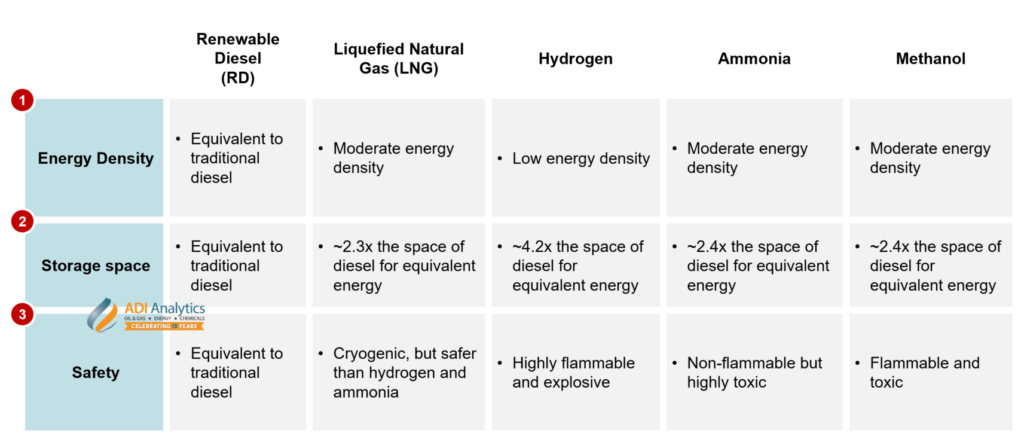
The global transition towards sustainable energy has placed green fuels at the forefront of efforts to decarbonize aviation, maritime, and heavy industries. These green fuels — renewable diesel (RD), liquefied natural gas (LNG), hydrogen, ammonia, and methanol — promise a low-carbon alternative to fossil fuels. However, mainstream adoption requires overcoming significant barriers, including scalability, infrastructure development, and complex safety issues.
Energy density and safety of green fuels
The critical physical attribute of a fuel is its energy density, which directly affects the storage and transportation requirements. Safety also remains a crucial hurdle in the adoption of green fuels. They often have lower energy density compared to traditional diesel, leading to the need for larger tanks with more complex storage and transportation systems. Exhibit 1 compares green fuels based on energy density, storage space, and safety profiles.

Exhibit 1: Energy Density, Storage, and Safety of Green Fuels.
Based on Exhibit 1, RD closely matches traditional diesel’s energy density and safety, making it the most compatible green alternative. In contrast, green fuels like LNG, hydrogen, ammonia, and methanol demand significantly more storage space—ranging from 2.3 to 4.2 times more than diesel to deliver the same energy. While LNG is comparatively safer than hydrogen and ammonia, LNG’s cryogenic nature still requires careful handling. Besides, hydrogen’s high flammability and ammonia’s toxicity also present significant concerns, requiring strict protocols. Methanol, though less hazardous than hydrogen and ammonia, requires stringent safety measures due to its flammability and toxicity. These factors further emphasize the complexities of integrating these fuels into existing systems.
The viability of future fuels can be assessed using five key dimensions: abundance, availability, affordability, assignment, and arbitrage. This framework addresses critical factors, including the scalability of fuel production, its reliability in meeting growing demand, cost-effectiveness compared to other alternatives, suitability for specific applications, and potential to unlock competitive market advantages. By addressing these dimensions, this structured approach offers a practical analysis of whether emerging fuels can move beyond theoretical potential to achieve real-world impact.
Exhibit 2 demonstrates the assessment of future fuels using this framework and offers a comprehensive perspective on their readiness for large-scale adoption.

Exhibit 2: Comparative Assessment of Future Fuels in 2024.
Based on Exhibit 2, alternative fuels are stepping into the spotlight with their unique strengths and challenges. RD, with moderate production levels and high availability, is a practical substitute for transportation needs, leveraging established supply chains and comparable costs. Similarly, LNG has high production capacity and scalability with robust global supply, competitive pricing, and versatility in many industrial applications, such as chemicals, plastics, and utilities. These characteristics position LNG as a transition fuel, capable of supporting significant demand across various sectors, including maritime transport.
In contrast, hydrogen, ammonia, and methanol face more significant challenges in adoption. For example, hydrogen offers moderate production capacity and promising applications in industry and aerospace, yet its ultra-expensive costs, strict safety requirements, and limited infrastructure hinder its large-scale adoption. Similarly, ammonia offers moderate production scalability but faces challenges due to its toxicity and is primarily confined to agriculture and emerging maritime sectors. Methanol faces similar barriers, with its niche applications in the chemical industry and high costs, which struggles to expand beyond specialized uses, although it holds potential in decarbonizing shipping. Together, these findings emphasize that while RD and LNG stand ready for near-term adoption, hydrogen, ammonia, and methanol require significant innovations to fulfill their potential in the green energy transition.
The current status of green fuels reveals a stark reality: they are still “a drop in the bucket” compared to traditional fuels. Widespread adoption of green fuels faces challenges like infrastructure gaps, high costs, and technological limitations in storage, production, and safety. However, the landscape is not without promise. Strategic investments, supportive policies, and ongoing innovations in production and handling technologies are poised to address these limitations. Enhancing efficiency and driving down costs could pave the way for green fuels to transition from niche applications to mainstream energy solutions, accelerating the shift towards a more sustainable and decarbonized future.
– Christine Ho
ADI Analytics is a prestigious, boutique consulting firm specializing in oil & gas, energy transition, and chemicals since 2009. We bring deep, first-rate expertise in a broad range of markets including hydrogen, ammonia, and other chemical where we support Fortune 500, mid-sized and early-stage companies, government agencies, and investors with consulting services, research reports, and data and analytics, with the goal of delivering actionable outcomes to help our clients achieve tangible results.
We also host the ADI Forum, one of Houston’s distinguished industry conferences, to bring c-suite executives together for meaningful dialogue and strategic insights across the oil & gas, energy transition, and chemicals value chains. Learn more about the ADI Forum, which is chaired by Uday Turaga, Founder & CEO, ADI Analytics, at www.adi-forum.com.
Subscribe to our newsletter or contact us to learn more.



















